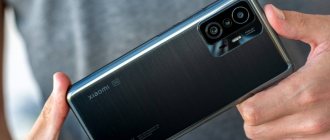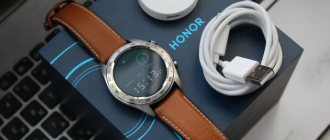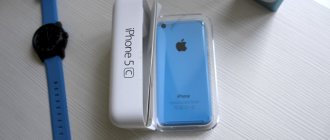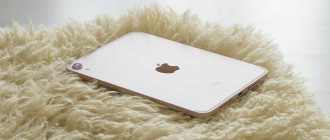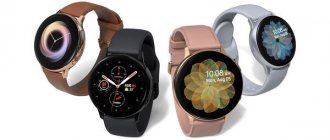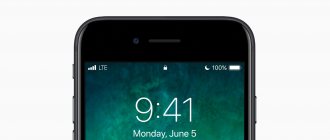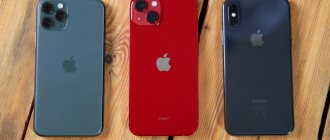Rumors that Apple will introduce a large iPhone in 2014 have been circulating since mid-2013. There was also talk of an even larger iPhone. This summer, brave Chinese workers stole so many spare parts from Foxconn factories that some even managed to assemble the entire phone... No one doubted the release of the iPhone 6, while not everyone believed in the iPhone 6 Plus. And on September 9, 2014, Tim Cook said from the stage that in addition to the new large iPhone 6, Apple will now sell the iPhone 6 Plus, a smartphone of impressive dimensions. Needless to say, what a stir there was around the new product. Some fans of the company immediately began to criticize the new product, recalling Apple to the words of Steve Jobs, who said that for convenience, the smartphone screen should not be large, and when using the iPhone, everyone could reach any point on the display with their thumb. Fans of Android devices felt that the iPhone 6 Plus was Apple's attempt to copy the design of other manufacturers' flagships. But there were also those who immediately decided to buy the iPhone 6 Plus - these are people for whom size played an important role.
I am the one who was happy about the release of the iPhone 6 Plus and was one of the first to purchase the new product. After three weeks of actively using the smartphone, I had accumulated a lot of impressions; the operating experience allowed me to directly evaluate the strengths and weaknesses of the device, and gave me time to formulate my thoughts into a full review.
Content
- Dimensions of the iPhone 6 Plus and their comparison with the iPhone 6 and iPhone 5s
- iPhone 6 Plus Design and Construction
- iPhone 6 Plus Hardware and Performance
- The iPhone 6 Plus display is a different story
- iPhone 6 Plus battery life
- Photo and video camera iPhone 6 Plus
- iPhone 6 Plus bends, breaks, tears out hair, fights and swears...
- Pros and benefits of iPhone 6 Plus
- Pros and cons of the iPhone 6 Plus
- What to choose: iPhone 6 or iPhone 6 Plus and how they differ from each other
- iPhone 6 Plus Specifications
- Official prices for iPhone 6 and iPhone 6 Plus in Russia
- Conclusion
Equipment
The design of the box is made in a minimalist style: on the lid there is a convex shape of a life-size smartphone without any images. On the side there is the inscription “iPhone” without a model designation.
The package includes the smartphone itself, a charger, a Lightning cable, EarPods with microphone, a SIM card ejector, two stickers and documentation. Nothing new.
Dimensions of the iPhone 6 Plus and their comparison with the iPhone 6 and iPhone 5s
The dimensions of the iPhone 6 Plus are one of the hot topics for discussion among both fans of Apple devices and haters, so it would be more logical to start with coverage of this aspect.
- iPhone 6 Plus
- Length: 158.1 mm
- Width: 77.8 mm
- Thickness: 7.1 mm
- Weight: 172 g
- iPhone 6
- Length: 138.1 mm
- Width: 67.0 mm
- Thickness: 6.9 mm
- Weight: 129 g
- iPhone 5s
- Length: 123.8 mm
- Width: 58.5 mm
- Thickness: 7.5 mm
- Weight: 112 g
It's clear that the iPhone 6 Plus is significantly larger and heavier than the iPhone 5s and iPhone 6, which of course makes it less convenient compared to smaller models.
But having decided to buy a 5.5-inch mobile device, it’s somehow strange to complain about such a seemingly disadvantage. You just need to accept this feature. And you have to understand that the iPhone 6 Plus is not a device that you can easily take out of your jeans pocket and just as easily put it back into your pocket. In addition, not all jeans pockets can absorb this hero. For example, this trick most likely will not work with women's jeans, trousers and other wardrobe items, but with men's clothing everything is simpler. But even if you manage to place the entire device in your pocket, when walking you risk significantly speeding up the process of wearing out the headphone plug, which every now and then gets caught under the bend of your body. You can also note some inconveniences when climbing stairs, but if you do not step over a step, then this problem is unlikely to affect you.
iPhone 6 Plus in women's and men's jeans It's not easy to deftly take the phone out of your pocket with one hand, but if you have already taken it out and are ready to help with the fingers of your second hand, the large screen will absorb you completely and you will no longer remember the frighteningly large size of the iPhone 6 Plus.
iPhone 4, iPhone 5, iPhone 6 Plus
Despite the fact that I consider the design of the iPhone 6 Plus to be quite successful, I would like to find fault with the wide frames along the edges of the display, which are much narrower in competing models from other manufacturers.
If the height of the phone is practically not confusing (158.1 mm), then the huge width (77.8 mm) is poorly compatible with the comfort of using the device with one hand. Photo by iMore. iPhone 6, iPhone 6 Plus, iPad Air and iPad Mini Retina
The weight of the phone is huge - 172 grams, but you are unlikely to remember this in everyday use. The phone doesn't feel too heavy, except when you're lying on the couch and you drop it on your face.
It is worth noting that the small thickness, only 7.1 millimeters, has a fairly good effect on the confidence with which you hold the phone in your hand. Although, quite a few critics and users note that it is difficult to confidently hold the iPhone 6 Plus with one hand and there is a high probability of dropping it. Apparently it depends on the size of the hands. In any case, you can always help with the fingers of your other hand.
Design, materials and build quality
The team of Jony Ive, who is responsible for the design of all Apple products, did not separate the design of the 6 Plus into a separate task, and simply stretched the iPhone 6 to a size that would fit a 5.5-inch display.
And if we ignore the size of the smartphone, it looks good. Apple managed to create a long-lasting design that will be relevant in a year if the company decides to release the iPhone 6s Plus. At the same time, even the plastic strips on the back cover, which I didn’t like so much in the iPhone 6, don’t look so alien here. In this regard, the dimensions of the case still play a role; the plastic dissolves against the background of the metal.
The materials in the iPhone 6 Plus are excellent. The front panel of the smartphone is covered with protective glass, and the sides and back are made of a single piece of anodized aluminum. The only plastic elements here are the strips at the top and bottom of the back cover, which are necessary for the normal operation of the smartphone's antennas.
There are not the slightest complaints about the build quality, the iPhone 6 Plus was assembled very well, all the elements of the case fit tightly. As for the possibility of bending a smartphone, it will be difficult to do this unintentionally. The body of the 6 Plus is durable and requires above average force to bend it. And if the device is somehow bent in a jeans pocket, then it will most likely be due to the fact that the owner could have made a mistake when choosing their size.
iPhone 6 Plus Design and Construction
When photos of the back panel of the iPhone 6 began to appear online, many people really didn’t like the thick plastic strips at the top and bottom of the case.
These inserts are necessary for the signal to pass through, since the housing materials prevent this in other places. Yes, in the photo the stripes really look disgusting, but in life attention is not focused on them at all, which cannot be said about the protruding camera, but more on that a little later. Can these plastic inserts be called a disadvantage? I think no. But it would be much better if they were made solid or, conversely, as thin as possible. But the protruding camera is really unpleasant. Of course, if you use a case, you won't even remember that the camera in the iPhone 6 and iPhone 6 Plus protrudes, and even without a case this feature won't bother you. You remember the protruding camera in two cases: when the phone is lying on a flat surface; and when the phone is lying on a dirty surface.
I didn't just talk about dirt. The protective glass of the camera is almost completely recessed, which ensures friction with any crumbs and grains of sand. Apple claims the iPhone 6 Plus' camera lens is protected by sapphire crystal, but I'm still worried about scratching it.
Otherwise, I liked the design of the new iPhone. The buttons fit perfectly, all connections are sealed to keep moisture out, and the sloping corners are so pleasant to the touch that you might think they're soft. The feeling of your finger rolling off the front panel is indescribable.
The Home button has also undergone changes. The Touch ID sensor has become significantly smaller; a pleasant edging has appeared, which gives the impression that the button has become smaller. The Power button has changed its location and is very convenient to use except when you need to take a screenshot. Sometimes you can accidentally press it when taking a photo. Bad, but not critical. You'll have to get used to it.
The design turned out really well. The phone seems monolithic, you can feel the quality of the materials used and it is very pleasant to hold in your hands.
Let's sum it up
Of the obvious disadvantages, I would like to note that the Siri voice assistant never received support for the Russian language, just as the Quick Type keyboard with predictive input of hints in Russian does not offer.
Both smartphones are truly the most refined and improved of the entire iPhone lineup.
The iPhone 6 is perhaps more convenient to use as a good smartphone, with its fast performance.
6 Plus is for those who cannot choose between buying a tablet or a phone: it has an excellent screen, a capacious battery and an excellent camera. If you are confused by the many rumors that it is too flexible, then I would like to reassure you. Accidentally bending a smartphone is quite difficult, unless you do it intentionally.
iPhone 6 Plus Hardware and Performance
The new iPhone models received an updated dual-core A8 processor (64-bit) and an M8 coprocessor.
Tests show that the performance increase relative to the iPhone 5s can hardly be called impressive. iPhone 6 and iPhone 6 Plus are only 20-25% more powerful than their predecessor, and in some synthetic tests the performance increase is even less than 10%. Apple A8 is manufactured using a 20nm process technology, and the lower this value, the higher the energy efficiency. In other words, the new processor, while performing better, consumes less power and generates less heat.
Despite the fact that the processor frequency in the iPhone 6 Plus is higher than in the iPhone 6, the phones show almost the same performance. This happens because the screen resolution of the 5.5-inch iPhone is higher than that of its smaller brother.
- Apple A8 in iPhone 6 Plus operates at 1.39 GHz
- Apple A8 in iPhone 6 operates at 1.2 GHz
- GPU in both phones – PowerVR GX6450
- Motion coprocessor in both phones – M8
As you can see, the GPU has also been upgraded. Instead of the old PowerVR G6430, the new iPhone roars PowerVR GX6450. And note that the key change in the model name is not the number 5, but the letter X. The PowerVR G6430 is an obsolete GPU from two years ago, while the GX6450 is a powerful modern GPU released this year.
Performance text ixbt.com
The GX6450 isn't just an improved processor. The GX6450 is a 4-cluster model of the six-cluster GX6650. For those who don't know, the GX6650 is one of the most powerful mobile GPUs that competes with the Tegra K1.
If you take into account that the iPhone 6 and iPhone 6 Plus took leading positions in the BASEMARK X synthetic gaming test, you don’t have to worry about a slight increase in performance relative to the iPhone 5s. The new Apple phones are indeed very powerful devices.
But what’s really sad is the amount of RAM, it remained at the level of iPhones of previous generations - 1 gigabyte of the LPDDR3 standard. This is damn small by modern standards, but in practice you are unlikely to notice this shortcoming.
You can read more about performance tests in this material. I also recommend looking at a more realistic comparison of the performance of the iPhone 6 in everyday tasks, relative to flagships from other manufacturers.
The new iPhones received the MDM9625M modem; it provides throughput of up to 150 Mbit/s on LTE networks, but for such a speed the operator must provide a wide range. It seems that in Russia only Megafon technically supports such a huge bandwidth.
The phone supports LTE networks of almost all cellular operators in the world, which can also be called an undeniable advantage.
Wi-Fi module in iPhone 6 and iPhone 6 Plus standard IEEE 802.11ac. Tests show that Wi-Fi data transfer speeds in practice can be up to 275 Mbit/s.
Also, the new iPhones received NFC support, although even iFixed could not determine its location on the motherboard. There is a version that the module is so weak that it is not able to provide sufficient data transfer speeds for everyday tasks. However, this does not matter, since NFC in the iPhone 6 Plus only serves for payments through the Apple Pay system. In other words, we can assume that the new iPhones do not have full NFC.
Remove the front camera of the device along with the light sensor:
This procedure should be performed as carefully as possible using a plastic tool with a sharp edge.
The iPhone 6 Plus display is a different story
As mentioned above, the iPhone 6 Plus has a 5.5-inch display with a resolution of 1920x1080 pixels.
The density is 401 pixels per inch. This is not the highest figure on the market, but it is higher than the iPhone 6 and iPhone 5s, which have a dpi of 326 pixels. Apple calls the new screen Retina HD, but I assure you, the increased resolution is not at all what surprises the display. It is so thin that even if you look closely, it is difficult to see the glass between your finger and the icon on the springboard. It creates an amazing impression that all elements of the iOS interface seem to stick to your finger.
The display contrast of the iPhone 6 Plus is 1300:1, resulting in blacks that are close to what we see on Amoled matrices, and whites that are almost flawless even when the phone is tilted significantly. Retina HD is 99% compatible with the sRGB color standard.
There is no need to talk about viewing angles, they are impeccable. The polarizer has also been improved; the display is now less susceptible to bright light.
I would like to note that the display on the iPhone 6 is a little better than on the iPhone 6 Plus. It displays whites and blacks better at obtuse viewing angles. This can only be noticed in complete darkness, and only if you keep both phones nearby.
Either way, the iPhone 6 and iPhone 6 Plus have some of the best displays on the market. Even DisplayMate, one of the world's most respected experts, concluded that Apple's new phones have the best mobile LCD display they've ever tested.
Experts note that it is wrong to say that the display of the Samsung Galaxy Note 4 or other Android flagship is better than that of the iPhone 6 Plus or vice versa, since they both strive for the ideal in “different weight categories.” The Note 4's display strives for the ideal Adobe RGB color palette, which is most commonly used in printing, while the new iPhone's display is designed for the sRGB palette, which is more in line with the colors we see in everyday life.
⇡#Design, construction
The appearance of the new iPhones is as unified as possible. The two models have almost identically thin bodies (6.9 mm for the iPhone 6, 7.1 mm for the iPhone 6 Plus), connectors and controls are located in the same places, the home button with a built-in Touch ID sensor is no different at the rate of. Only the perimeter of the case has been stretched to accommodate a 5.5-inch display. In order to maintain the frame proportions characteristic of the iPhone 6, the space above and below the screen has also been slightly increased. But the rest is absolutely the same.
iPhone 6 Plus vs iPhone 6
iPhone 6 Plus vs iPhone 5s
And this is good. The updated design is perfect for a large format, if not better than for a standard iPhone. The rounded corners and convex shape of the glass help hide the child-sized dimensions of the smartphone. In addition, the author of the article had a specific complaint about the design of the iPhone 6. Compared to previous iPhones, starting with the iPhone 4, the feeling of luxury and solidity that right angles and shiny bevels gave was lost. And with the market full of phones with curved edges, the iPhone 6 lost the features that instantly set it apart from its rivals. From a long distance, the six, especially in the white version, can easily be confused with some Samsung Galaxy S3.
iPhone 6 Plus vs iPhone 6
The iPhone 6 Plus changes everything in subtle ways. The large size and weight compensate for the soft design features. Everything is solid as before. You pick it up - you have the thing. But don't get me wrong: the iPhone 6 Plus is not too large or heavy in its class, it weighs about the same as a Samsung Galaxy Note 3-4, and has approximately equal dimensions in length and width.
For iPhone 6 Plus there are branded leather or silicone cases
iPhone 6 Plus battery life
It must be admitted that the iPhone has not demonstrated outstanding battery life compared to competitors from the Android camp for a long time, and the reason was the small dimensions of Apple phones, which did not allow the use of a physically large and capacious battery.
What can't be said about the iPad and Macbook, their battery life has always been amazing, and with the advent of the large iPhone 6 Plus, Apple was able to use a very capacious battery. Let's compare the official figures:
- iPhone 6 Plus
- Capacity 2915 mAh
- Talk time: up to 24 hours
- Standby time: up to 384h
- Video: up to 14h
- Music: up to 80h
- Internet 3G: up to 12h
- Internet LTE: up to 12 hours
- Internet Wi-Fi: up to 12 hours
- iPhone 6
- Capacity 1810 mAh
- Talk time: up to 14 hours
- Standby time: up to 250h
- Video: until 11h
- Music: up to 50h
- Internet 3G: up to 10h
- Internet LTE: up to 10h
- Internet Wi-Fi: up to 11h
- iPhone 5
- Capacity 1570 mAh
- Talk time: up to 10 hours
- Standby time: up to 250h
- Video: up to 10h
- Music: up to 40h
- Internet 3G: up to 8h
- Internet LTE: up to 10h
- Internet Wi-Fi: up to 10h
As you can see, the iPhone 6 Plus has impressive battery life, but that's just in numbers, what's it like in real life?
In practice, the phone can actually work for a very long time, so long that I have never been able to completely shut it down. If you only make calls and periodically surf the Internet, then the battery charge may well be enough for two full working days.
And there is no need to look towards the Android camp, where phones have a more capacious battery. The iPhone 6 Plus achieves these results by optimizing iOS and using more energy-efficient hardware. What is one GX6450 worth...
Eventually
The iPhone 6 Plus makes a strange impression: on the one hand, this is an iPhone whose display has grown significantly, which means more information can fit on it, but on the other hand, Apple’s detached attitude towards the problem of ergonomics is frankly upsetting. Bottom line, when you're playing games or watching a movie on the 6 Plus, you'll enjoy how nice it is to have a smartphone with a large display, but when it comes to everyday tasks, it's very difficult to operate the device with one hand. I don’t know what audience the iPhone 6 Plus was intended for, but it’s clearly not a smartphone for the average iPhone user. This does not mean that it is bad, on the contrary, Apple released a device with a good display, performance, camera and battery life. It’s just intended more for those who would like an iPad, but had no desire to buy a tablet in addition to a smartphone.
Liked:
+ Materials and build quality + Thinness + Display + Performance + Camera + Battery life + Volume and quality of external speaker
Did not like:
— Ergonomics — Dimensions and weight — No 32 GB version — No memory card slot — Price in Ukraine
Photo and video camera iPhone 6 Plus
The new iPhones feature an 8-megapixel iSight camera with a 1.5µ pixel size.
Since the iPhone 5s, it has undergone few changes, but there are some. Focus Pixels technology has appeared, which allows the camera to autofocus faster. Don’t think that this technology is something super new and incredible; competitors have analogues, but they have different names.
Among other things, I would like to note the increased resolution of panoramic images to 43 megapixels.
The iPhone 6 Plus has optical image stabilization, which is not present in the iPhone 6. And some even complain about it, claiming that it creates a motion sickness effect if you look at the phone screen for a long time. No matter how I tried to feel such a curious effect, nothing worked. Perhaps something can be noticed, but it is difficult to call it a minus or disadvantage.
It’s also worth noting the dual True Tone flash, which was there before, but in the new iPhones it has a round and more compact shape. True Tone allows you to take better pictures in poor visibility conditions.
Example photo in low light conditions without flash and with flash
Otherwise, the camera in the iPhone remains the same as in the iPhone 5s; it is a five-element lens protected by sapphire glass, with an ƒ/2.2 aperture, a light sensor on the rear panel and a hybrid IR filter.
8 megapixels – is this not enough or is their number completely unimportant? On mobile-review.com there was a small comparison of the cameras of the iPhone 6 Plus and the Samsung Galaxy S5, which has a 16 megapixel camera. I decided to cut out the same fragment of photos and reduced them to the same size, resulting in a visual comparison of the cameras of the two flagships. I suggest you familiarize yourself with the results.
iPhone 6 Plus on the left, Galasxy S5 on the right. Photo mobile-review.com
As you can see, in most cases the iPhone 6 Plus camera takes better pictures than the Galasxy S5 camera. But in low-light conditions, the Samsung phone takes better pictures.
The video camera has also been updated. The camera was able to shoot video at a speed of 240 frames per second. This means that we can shoot video and view it 8 times slower, although its quality leaves much to be desired.
On Youtube you will find many examples of gorgeous 240fps Slomo videos shot on the iPhone 6, but I was not able to make a single video that could be called excellent. The resolution in this mode is lower, and if the lighting in the room is slightly dim, the quality will be simply disgusting.
But the same can't be said for shooting HD video at 1080p resolution. The video quality is excellent, and if you take into account the fact that the new iPhone 6 uses autofocus tracking technology, even dynamic scenes in shaking hands look decent on video. This is great.
⇡#Screen
The way you use the iPhone 6 Plus is more like a tablet than a smartphone. One-handed control is impossible, unless you balance the device on your fingers, releasing it from your palm. And, by the way, the Reachability function - of dubious, according to the experience of your humble servant, usefulness for the iPhone 6 - is quite in demand on the 6 Plus. iPhone 6 Plus requires a second hand, but Reachability reduces the amount of movement required to move it from a stable position to the top edge of the screen.
Reachability is activated by double-tapping the ring around the home button
The landscape mode in many applications on the iPhone 6 Plus is copied from the iPad, where the window is divided into two vertical sections with independent scrolling. Keys for quickly formatting text and moving the cursor have been added to the landscape keyboard.
The desktop also flips into landscape orientation (only the dock remains in place) or even upside down.
And now about the mysterious resolutions of the iPhone 6 Plus. The iPhone 6 has an unusual resolution of 750x1334, but this can be explained simply: in this way, Apple has kept the number of pixels per inch, unchanged since the iPhone 4 - 326 PPI. The iPhone 6 Plus received a completely ordinary screen - 1080x1920 pixels, and this, with a diagonal of 5.5 inches, means a density of 401 PPI. However, the icons still look almost the same in size as on the iPhone 6. In addition, it became known that the iPhone 6 Plus renders images in an internal resolution of 1242x2208. Why is this necessary?
To explain everything, you'll need a little excursion into iOS user interface programming.
- The coordinates of all objects on the screen are specified in points. Unlike pixels, these are abstract units that can be whole or fractional. The main thing is that Apple uses the same screen dots per inch density across the entire iPhone line - 163 PoPI (to distinguish between dots and pixels per inch, we will refer to them as PoPI and PiPI, respectively). Thanks to this, if we draw a button with a size of 100 pixels in the program, we can be sure that on the screens of all devices it will take on the same physical size.
- On models prior to iPhone 4, the display pixel resolution is the same as the dot resolution. Subsequent iPhones with Retina displays have double the pixel density on each side of the screen: 326 PiPI and 163 PoPI, respectively. Why at two? Thanks to the whole ratio of PiPI and PoPI, the developer knows: in order to fit a bitmap image into a rectangle with a side of 100 pixels and not lose clarity, it must have a size of 200 pixels. Things wouldn't be so simple if the scaling was done with a factor of, say, 1.25.
- By increasing the screen size first in iPhone 5 and then in iPhone 6, Apple maintained the dots per inch density (163 PoPI), ensuring the same physical size of interface elements. But the lengths of the sides of the screen at points have increased. Program developers simply had to move interface elements to take up the free space.
And now we come to the iPhone 6 Plus. If we transfer the previous rules to a screen with a diagonal of 5.5 inches and an aspect ratio of 9:16, then we should use a matrix with a physical resolution of 880x1562 pixels, and the area available to programs in pixels should be increased to 440x781. Then both the pixel density and the physical dimensions of objects would remain the same, only the amount of information available to the eye would increase.
An alternative option is to go for 3x scaling using a 1320x2343 pixel matrix. This would increase the pixel density to 489 PiPI - nothing fantastic for modern screens. Of course, at the cost of the fact that to adapt applications it would be necessary to replace bitmaps with larger copies.
However, in the iPhone 6 Plus we find a matrix not with such an exotic, but with the most common resolution of 1920 × 1080 pixels, which means a density of 401 PiPI. Why this happened is anyone's guess. Perhaps Apple was unable to supply the required screens in sufficient quantities. Maybe they simply decided to save money. However, the resulting ratio of 401 PiPI to 163 PoPI is not whole. This is approximately 2.46:1. You can’t leave it this way, otherwise it’s impossible to accurately match visual resources to the coordinates on the screen in programs.
Here's the trick. The screen has dimensions in pixels of 414x736, and the picture is rendered with a 3:1 scaling - in a “virtual” resolution of 1242x2208 pixels. Still no problem with app design!
The image is then compressed to 1080x1920 pixels (a ratio of exactly 1.15:1 between internal resolution and physical resolution). In principle, any repeated scaling blurs the image to some extent. But in practice - although it's hard to believe until you see it with your own eyes - nothing like this is noticeable on the iPhone 6 Plus screen. Moreover, the image is much clearer than on the iPhone 6, because the PiPI of the screen is higher. Apparently the high resolution simply hides any blurry edges.
In addition, the simple formula 1x3/1.15 allows, with clear limitations, to create graphics with precision down to the physical pixel. By the way, apparently, this is why the screen size in pixels is exactly 414x736, and not 440x781, as we calculated above. Apple played around with PoPI a bit to get the final scaling to a strict 1.15:1 ratio. The screen density of the iPhone 6 Plus is 153.7 PoPI versus 163 PoPI previously adopted. Therefore, objects on the iPhone 6 Plus are slightly larger than on other iPhones.
What can we say in the end? Ideally, Apple should have used a sensor with 2x or 3x native resolution PoPI upscaling, and the fact that the iPhone 6 Plus doesn't have it is, of course, a failure. On the other hand, it was possible to compensate for it using software with almost no consequences. Moreover, if in the future there is a device with a threefold ratio of PiPI and PoPI, applications will not require any adaptation at all.
iPhone 6 Plus bends, breaks, tears out hair, fights and swears...
Does iPhone 6 Plus bend?
Yes, it bends. It also burns and beats. My beer glass breaks too, and my laptop doesn't survive being hit against the wall. Over the years, everyone has been testing the strength of the iPhone in various ways. Even the iPhone 4 was bent by some, but this means that the phone can be bent under normal operating conditions. Yes, this trick is much easier to do with the iPhone 6 Plus. You can, of course, say that Apple screwed up and any child can bend their new product, but any child can also break any other smartphone. The question is not the quality of materials and design, but the strength and desire to break something.
I've been using the iPhone 6 Plus for three weeks. I walk through 1-2 flights of stairs, sleep on my phone when I can’t find the strength to get up for work and calmly squat down in order to pick something up from the floor or tie shoelaces even in skinny jeans, while the device rests quite firmly on the leg... I responsibly declare that the iPhone 6 Plus is almost impossible to bend in everyday use. This can only be done on purpose, by exerting yourself.
I'm also really amused by this whole hair-pulling thing. Someone somehow manages to make sure that beard hair gets into the almost sealed gaps between the elements of the body. And then, suddenly, the hair gets stuck there and gets pulled out. I love a beard, I walk around with a beard 70% of the time and the iPhone 6 Plus has not plucked a single hair from me in 3 weeks. Brad, and that's all.
The iPhone 6 Plus is beating, you have to live with it. It all depends on how it falls and on what. But breaking an iPhone is not as easy as it seems. My iPhone 4 has survived so many falls on a variety of surfaces that it should have broken long ago, but it didn’t. And this is nothing more than an accident. The same thing can happen with any other phone. If you are afraid of breaking it, wear a cover.
Raise the front camera of the device and remove the earpiece:
This procedure should be performed as carefully as possible using a plastic tool with a sharp edge.
Pros and benefits of iPhone 6 Plus
Let's summarize and list all the pros and benefits of Apple's new flagship.
- iPhone 6 Plus is thin. It is really very thin, which has a good effect on how it fits in the hand. Its thickness is only 7.1 mm, while the Nexus 6 is 10.06 mm and the Galaxy Note 4 is 8.5 mm.
- The phone's body makes a good impression. We see a product that is truly holistic and precise down to the millimeter, and the first-class build quality once again gives you reason to be impressed by the design of the iPhone 6 Plus.
- The phone body is incredibly ergonomic. It is very easy to get used to and with sufficient length of fingers, it is not difficult to use with one hand. The sloping edges create the impression of softness, and the moderate width helps you hold the phone more or less confidently in your hand.
- Whatever they say, the iPhone 6 Plus has a magnificent screen and its magic lies not only in the large viewing angles, but also in the incredible proximity of the image to the front of the phone. If you don’t like the pungent colors of Amoled displays and want to observe the most realistic color reproduction, then the iPhone 6 and iPhone 6 Plus will satisfy you 100%.
- The iPhone 6 Plus has a good camera, which is not about the number of megapixels, but about the quality of the pictures. You don’t have to try to hold the phone as level as possible and take a long time to “aim”; the camera will do most of the work for you.
- Huge battery life. Although the iPhone 6 Plus does not have the most capacious battery, it allows you to work without recharging for a very long time. Sometimes the phone lasts two days and I can’t say that I have to save battery power.
⇡#Hull strength
While we've already wondered whether the cases of the new iPhones are really easy to bend, it's worth revisiting the topic since the iPhone 6 Plus is the one in the cases of permanent deformation reported by customers.
So, on the one hand, there are several claims on the Internet from people who allegedly ruined the iPhone 6 Plus without doing anything out of the ordinary. For example, they just sat with the device in the front pocket of their jeans. Apple admits in an official statement that there were such complaints: “In our first six days of sales, a total of nine users contacted Apple citing flex in the iPhone 6 Plus.”
Now let's reason. Considering that 10 million iPhone 6 and iPhone 6 Plus units were sold in the first three days alone, it is not at all surprising that some percentage will have manufacturing defects. Even if you subtract the share of a simple iPhone 6 from the mass of devices sold, nine cases per million does not correspond to a trend at all.
Plus, the iPhone 6's body isn't as simple as it seems. Apple writes: “They (iPhone 6 and 6 Plus. - Editor's note ) are also equipped with stainless steel and titanium inserts for structural strength under heavy-duty conditions. We also conduct extremely rigorous testing throughout all stages of development, including 3-point bending, cyclic point loading, torsional loading and various user scenarios including sitting on the device.”
Finally, there are the results of independent tests from Consumer Reports, which tested the durability of both the iPhone 6 Plus and iPhone 6, as well as smartphones from Samsung, LG and HTC. It turned out that to irreversibly deform the iPhone 6 Plus, a force of 40.8 kg is required, applied to a small area across the body in the area of the bottom volume key (where the design is said to have a weak point).
For comparison, the metal HTC One M8 deforms under a load of 27 kg, but smartphones with predominantly plastic bodies - the LG G3 and Samsung Galaxy Note 3 - can withstand loads of up to 59 and 60 kg, respectively. In general, there is nothing surprising here. The choice of body material is always a compromise. Aluminum, in addition to its aesthetic advantages, is not susceptible to chips and cracks upon impact and does not lend itself to light pressure. But under severe pressure, aluminum bends irreversibly, while plastic or plastic on a steel frame experiences elastic deformation.
In general, there is no need to mock or lament the fact that the iPhone simply obeys the laws of physics. Everything is not nearly as scary as it seems.
Pros and cons of the iPhone 6 Plus
We must not forget about the shortcomings. I tried to put together all the objective complaints that may arise against the iPhone 6 Plus and each of them is fair in its own way.
- High price. And there is no need to say that it is high in Russia; on the contrary, this year the Russians found themselves in a rather advantageous position. Our prices for new iPhones are not much higher, if not cheaper, than in other countries. The phone itself is more expensive than its competitors, among which I see the Nexus 6, Note 4 and LG G3.
- The usable space of the front panel is smaller compared to its competitors. As a result, other flagships, with the same dimensions, have a significantly larger display diagonal.
- Wide frames. And we’re not even talking about the possibility of increasing the display, but about the excessive width, which creates inconvenience when printing text in horizontal orientation.
- The camera sticks out. The disadvantage is minor, since after a few minutes you don’t pay any attention to it, but the risk of damaging the protective glass of the lens increases.
- Plastic inserts. The downside is very dubious, since the stripes don’t look that bad in real life. By the way, the first scratches I got were on them, and not on the apple or the anodized surface.
- Unusual location of the Power button. It's easy to use, but when taking photos or changing the volume, you'll find yourself accidentally pressing it until you get used to it.
- The iPhone 6 Plus is not much more productive than the old iPhone 5s. But this happened because Apple in the 5s used a very powerful processor for its time and it was impossible to make leaps and bounds in a year.
- Small amount of RAM. By modern standards, 1024 megabytes of RAM is very little. Most users won't notice this, but if you actively use many programs, you will encounter programs being unloaded from RAM too quickly. The problem doesn't appear often, but it does exist.
- Defective NFC module. It's so limited in the iPhone 6 and iPhone 6 Plus that it's completely unfair to say it's available. NFC here serves only ApplePay; it is not capable of receiving and sending files or making a wireless connection with accessories.
- No 4K video shooting. The camera is good, even very good, but video shooters will be disappointed by the lack of 4K shooting. Whatever they say, 4K video is really much better quality than Full HD.
- Unadapted applications. The disadvantage is temporary, but it does happen. Almost a month has passed since the release of the iPhone 6 Plus, and most of the most popular games and programs are stupidly stretched to fit the large display, looking cloudy and foreign. The magic of the gorgeous screen dissipates.
- Supplied with a 5 W power adapter. It’s a pity that for such a price we get such a simple adapter, and this despite the fact that the iPhone 6 Plus can be infected from a 12W adapter.
⇡#Testing: performance
Test participants
- Apple iPhone 5 (Apple A6)
- Apple iPhone 5s (Apple A7)
- Apple iPhone 6 (Apple A8)
- Apple iPhone 6 Plus (Apple A8)
- HTC One M8 (QS 801)
- LG G3 (QS 801)
- Samsung Galaxy Note 3 (Samsung Exynos Octa 5420)
- Samsung Galaxy S5 (QS 801)
- Sony Xperia Z3 (QS 801)
In addition to the flagship smartphones from other manufacturers that were used in the iPhone 6 test, for comparison with the iPhone 6 Plus we used two competing “lamps”: the LG G3 and, of course, the Samsung Galaxy Note 3. We have not yet had the opportunity to test the recently released Galaxy Note 4 in business. Not every device has been tested in all benchmarks at one time, so don’t be surprised that some positions in the charts are empty.
AnTuTu Benchmark 5
New iPhones took the highest places on the pedestal with results significantly higher than those of gadgets based on Qualcomm’s top SoC. Among the latter, the Samsung Galaxy S5 and HTC One 8 have the best performance. The rest can only compete with the obviously weaker iPhone 5s.
SunSpider 1.0.2
In the CPU performance test, the iPhone 6 and iPhone 6 Plus are the undisputed leaders. There is a significant increase in performance compared to the previous generation of Apple SoC. Among other smartphones, the Samsung Galaxy Note 3 based on the Exynos Octa 5420 SoC performed best, although it is almost twice as slow as the iPhone 6 Plus. Products powered by Qualcomm Snapdragon 801 are located at the bottom of the chart in accordance with the operating frequencies set by the manufacturer. The LG G3 performed especially poorly, leaving even the iPhone 5 ahead.
Google Octane 2.0
In a similar browser test, the iPhone 6 and 6 Plus won. The advantage of the new products over the iPhone 5s is no longer as great as in the previous test. But competing smartphones still lag catastrophically behind.
GFXBench 3.0 (T-Rex HD)
First, we need to clarify the fact that the iPhone 6 Plus is not only on par with the iPhone 6 when rendering to an invisible frame buffer (offscreen) at 1080p resolution, but is also not inferior when rendering to the screen. In fact, the current version of GFXBench simply does not support the resolution of the iPhone 6 or the resolution of the iPhone 6 Plus, and treats them as the iPhone 5(s). It turns out that the four Apple smartphones in this test can be compared only in terms of Offscreen - bare GPU performance. In this regard, the iPhone 6 and iPhone 6 Plus are almost equal, but it is clear that when rendering at an internal resolution of 1242x2208, the iPhone 6 Plus has a harder time than the iPhone 6 with a physical resolution of 750x1334 pixels.
The same applies to smartphones from other manufacturers that have 1080x1920 screens. But judging by the frame rate in Offscreen, the iPhone 6 Plus should be fast enough to absorb this difference. In fact, Apple has almost twice the GPU results of the best Qualcomm Snapdragon 801-powered devices.
3DMark Ice Storm Unlimited
In the overall 3DMark ranking, the placement of competitors is completely different, and here's why. A big contribution to the final score, in addition to the GPU, is the CPU performance in physics calculations. And here dual-core SoCs find themselves in unfavorable conditions. Due to the fact that physical calculations are not very predictable, a “wide” CPU cannot actively use out-of-order execution of instructions. On the other hand, physics is perfectly parallelized across multiple threads, which is why Qualcomm and Samsung quad-core SoCs benefit. As a result, we have parity between the iPhone 6 (Plus) and smartphones based on not overclocked QS 801 chips in terms of the final score in 3DMark. But progress compared to the iPhone 5s is obvious.
What to choose: iPhone 6 or iPhone 6 Plus and how they differ from each other
In addition to a larger battery, longer battery life, and optical camera stabilization, the iPhone 6 Plus has several other differences that Apple didn't talk about at the presentation. Both phones have great displays, but the iPhone 6 has a higher contrast ratio for more realistic blacks and whites.
- iPhone 6 Plus
- 1920x1080 pixels
- 401 pixels/inch
- Diagonal 5.5 inches
- Contrast ratio 1300:1
- iPhone 6
- 1334x750 pixels
- 326 pixel/inch
- Diagonal 4.7 inches
- Contrast ratio 1400:1
Despite the fact that both the iPhone 6 and iPhone 6 Plus have an Apple A8 processor, they operate at different clock speeds of 1.2 GHz and 1.39 GHz, respectively.
What to choose - iPhone 6 or iPhone 6 Plus? This is a difficult question to which there is no clear answer. On the one hand, we have a huge phone with an impressive display on our favorite mobile operating system, on the other, everything is the same, but just smaller.
The dimensions of the iPhone 6 Plus are its undeniable advantage over its younger brother and at the same time are its main disadvantage. And if you are not afraid of large dimensions and the price does not bother you at all, then the iPhone 6 Plus is 100% your choice, otherwise you should take a closer look at the 4.7-inch model. But you should remember that when buying an iPhone 6 Plus, you are not purchasing the most powerful and technologically advanced phone, but the most expensive, and this is important to understand so as not to regret your purchase later.
⇡#Testing: display
The screen brightness of the iPhone 6 Plus is not as bright as that of the iPhone 6. Still, it is one of the brightest displays used in gadgets. Among devices with IPS matrices, only the iPhone 5s and Sony Xperia Z3 have significantly higher brightness. The Samsung Galaxy S5 with an AMOLED screen produces colossal brightness, but only if the white color occupies 20% of the screen area and in bright ambient light. In other conditions, the brightness of the white field drops significantly below the level of the iPhone 6 Plus. The entire range available to the Galaxy Note 3's AMOLED screen is also below the iPhone 6 Plus's limit.
In terms of contrast, the iPhone 6 Plus is in no way inferior to the iPhone 6. Among IPS matrices in gadgets, this is an unsurpassed result; only AMOLED screens with almost infinite contrast are better.
Both iPhones cover almost the entire sRGB color space. The color rendering setting is approximately the same - and shifts the image tone towards cool tones.
Gamma curves are almost ideal, which indicates uniform color rendering across the entire brightness range and balanced image contrast.
Testing: Battery Life
If we test devices at maximum screen brightness, the iPhone 6 Plus is not in the best position. The list is led by the Galaxy S5, which in normal situations is often inferior in brightness to the iPhone 6 Plus, and the obviously less bright Galaxy Note 3 and HTC One M8. There is quite a significant gap between the iPhone 6 and 6 Plus, although not as much as one would expect given the difference in battery capacity.
iPhone 6 Plus Specifications
| Display | IPS 5.5 inches (16:9), oleophobic coating Resolution 1920 x 1080 px (401 ppi) | |||
| CPU | Apple A8 (2 cores, 20nm, 64-bit) Frequency 1.39 GHz, Apple M8 coprocessor | |||
| GPU | PowerVR GX6450 | |||
| Memory | 1 GB DRAM DDR3 | |||
| Storage capacity | 16/64/128 Gb | |||
| Camera | iSight 8 Mpx/1.5µ, f/2.2 lens, dual LED flash Full HD 1080p/30-60fps recording, HD 720p/120-240fps. Optical stabilization. | |||
| Front-camera | 1.2 Mpx/2.2µ, f/2.2 HD video recording 720p/30fps | |||
| Sensors, modules Other | Biometric fingerprint sensor, GPS, Glonass, proximity sensor, light sensor, gyroscope, Nano-SIM accelerometer, digital compass, 3 microphones, hotspot, wireless printing, AirPlay Mirroring, dual flash, continuous shooting, slo video shooting -mo, NFC, barometer | Battery (hours of operation) | ||
| Music Video Talk Internet 3G Internet LTE Internet Wi-Fi Standby | up to 80 up to 14 up to 24 up to 12 up to 12 up to 12 up to 384 | 2,915 mAh | ||
| iOS version Start of sales | iOS 8.0 19.09.2014 | Dimensions (mm) | ||
| Length Width Thickness | 158.1 77.8 7.1 | 172 grams | ||
| Communication standards | GSM/GPRS/EDGE, UMTS/HSUPA/HSDPA (3G), CDMA, LTE (4G), Wi-Fi (802.11 a/b/g/n/ac), Bluetooth 4.0 | |||
Conclusion
iPhone 6 Plus exceeded my expectations.
I can’t call myself a selfless fan of Apple technology, but I’ve been using their phones for many years and this is the first time I’ve experienced such strong satisfaction from a purchase. Moreover, you really don’t get to know this phone right away, but only after a week or more... The iPhone 6 Plus is not just a “big iPhone”, it is a real “tablet phone”, which has as much from the iPad as from the usual iPhone. This is something in between and this is its undeniable advantage. Most likely, after purchasing the 6 Plus, you will completely give up using the iPad, and that’s not a bad thing... The iPhone 6 Plus has many shortcomings, but as always, you will remember them with a grin only when fans of Android smartphones point them out to you. The phone has too many pros to pay attention to the cons.
We also have a Telegram channel. It is also very convenient to follow the news on the app.
operating system
Both smartphones run on iOS 8. Among the new features is (Reachability) and a function that makes it easier to work with a smartphone with one hand - choosing the optimal image scale: standard or enlarged, which makes icons and text larger.
If the iPhone 6 Plus is placed horizontally, then it turns on the “tablet” mode, which arranges interface elements like on the iPad. For example, in Safari there are bookmarks on a separate panel, and in Messages - contacts.
Unfortunately, when you hold the 6 Plus with both hands, your index finger may block the speaker on the bottom edge.

